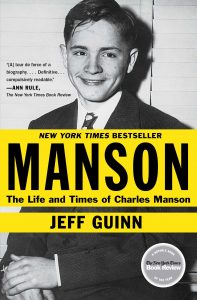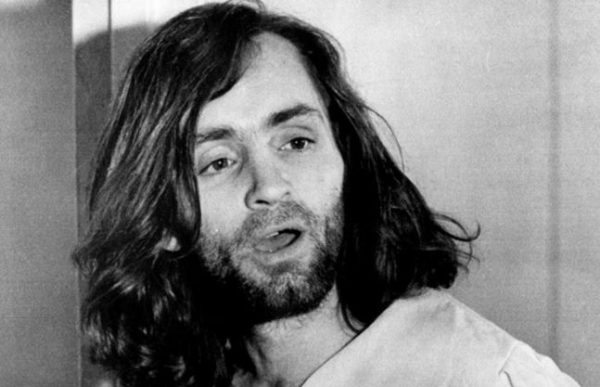In 2013, author Jeff Guinn produced a formidable book, Manson, about one of the 20th century’s most enigmatic figures. We enjoyed Guinn’s new look at Charles Manson, and we were interested in the way he carefully placed Manson’s Scientology involvement in context.
With Manson’s death last night in California, we know there’s going to be a huge surge in interest in the 83-year-old prison inmate known for ordering a bizarre and horrific murder spree in 1969. And with that new interest will come questions about Manson’s involvement in Scientology.
It was the New York Times that first revealed the connection between Manson and Scientology in 1969. Paulette Cooper then added details in her 1971 book The Scandal of Scientology. And Scientology’s own internal documents, seized in a 1977 FBI raid, also show that the church was concerned about Manson’s activities and how they might reflect on Scientology.
 According to one Guardian’s Office report, Manson had undergone some 150 hours of auditing while he was at McNeil Island Penitentiary in the 1960s — and Jon Atack pointed out to us that 150 hours was more auditing than he’d received in his entire Scientology career, which had got him to OT 5. According to the GO document, Manson’s cellmate, Lafayette Raimer (whose real name turned out to be Lanier Ramer), was a trained auditor who put him through various Scientology processes, including CCH (Control Communication Havingness) processes, with the auditor asking paired questions like “Who have you helped?” and “Who have you not helped?” and other “Havingness” questions like “What can you have?” “Look around and find something you can have.” (Newcomers to the subject may not be aware that actual Scientology processes — the stuff you actually do in session with an E-meter — consists of such simple questions asked endlessly. For more about it, see our series “Up The Bridge” with Claire Headley, who helped us understand CCH processes and shouting at ashtrays.)
According to one Guardian’s Office report, Manson had undergone some 150 hours of auditing while he was at McNeil Island Penitentiary in the 1960s — and Jon Atack pointed out to us that 150 hours was more auditing than he’d received in his entire Scientology career, which had got him to OT 5. According to the GO document, Manson’s cellmate, Lafayette Raimer (whose real name turned out to be Lanier Ramer), was a trained auditor who put him through various Scientology processes, including CCH (Control Communication Havingness) processes, with the auditor asking paired questions like “Who have you helped?” and “Who have you not helped?” and other “Havingness” questions like “What can you have?” “Look around and find something you can have.” (Newcomers to the subject may not be aware that actual Scientology processes — the stuff you actually do in session with an E-meter — consists of such simple questions asked endlessly. For more about it, see our series “Up The Bridge” with Claire Headley, who helped us understand CCH processes and shouting at ashtrays.)
In his book, Guinn took a new look at the forces that shaped Manson, and he mentioned Scientology numerous times. We thought you’d like to see some of the conclusions he came to.
Manson was in and out of prison much of his young life. During one stint from 1957 to 1958 at Terminal Island, a minimum-security federal prison in Los Angeles, Manson took a Dale Carnegie course, based on Carnegie’s 1936 book, How to Win Friends and Influence People. Manson was released from that prison on September 20, 1958, but was arrested again on June 1, 1960 and a year later was sent to McNeil Island Penitentiary in Washington state to serve a 10-year term.
It was at McNeil Island that he was put in a cell with Lanier Ramer and underwent Scientology auditing. Here’s what Guinn says about it…
For Manson, prison meant not just security but school. Though he didn’t sign up for any of the academic or work training courses available at McNeil, he continued his education there all the same. McNeil had inmates who were glad to share information on a variety of subjects, black and white magic and hypnotism among them. There was a large fellowship of born-again Christians eager to bring Charlie closer to God, but he’d had enough of that. The group that really captured his attention, less for his acceptance of their spiritual beliefs than the way in which they expressed them, was the Scientologists.
Much as Dale Carnegie introduced his sales philosophy to the general public with How to Win Friends and Influence People in 1936, in 1950 pulp writer L. Ron Hubbard utilized the best-selling Dianetics: The Modern Science of Mental Health to publicize his technique of achieving mental health and happiness. Carnegie’s focus was on changing the perceptions of other people; Hubbard taught how to change yourself. He advocated “auditing,” confronting traumatic events in the past to move beyond them, becoming free of old fears and restraints and moving toward a “clear” or theta state where the mind is able to embrace spiritual freedom without negativity. In 1954, Hubbard and his growing legion of followers founded the Church of Scientology in Los Angeles, with an emphasis on certain “essential tenets”:
You are an immortal spiritual being.
Your experience extends well beyond a single lifetime. And your capabilities are unlimited, even if not presently realized.
Furthermore, man is basically good. He is seeking to survive. And his survival depends upon himself and his fellows and his attainments of brotherhood with the universe.As he had with Dale Carnegie, Charlie adopted those aspects of Hubbard’s teachings that lent themselves to manipulating others. He still projected himself in the future as a pimp, not a spiritual advisor. Most potential prostitutes had terrible self-images. Telling such girls that they didn’t have to be crippled by the past, that they were immortal spirits temporarily trapped in their bodies, that they were basically good and capable of achieving anything — these could be powerful recruitment techniques. Meanwhile, proclaiming himself as a wholehearted rather than a calculating Scientology convert had immediate advantages. Prison officials were always glad when inmates embraced a faith that encouraged positive attitudes. Faith helped boost potential for parole. As a relatively new arrival at McNeil, Charlie had a long way to go before parole, but conning evaluators into believing he had become a devout Scientologist was a good first step. His September 1961 report noted, “He appears to have developed a certain amount of insight into his problems through his study of [Scientology]. Manson is making progress for the first time in his life.”
Later, Guinn notes that Manson shared his understanding of Scientology with one of McNeil Island’s most famous residents…
In prison, Charlie chose friends for what he could learn from them. The Scientologists had their uses. So did McNeil’s most famous inmate. Alvin “Creepy” Karpis became notorious in the 1930s as a member of the Barker Gang. Initially imprisoned in 1936, Karpis was transferred to McNeil in 1962 after the government closed down Alcatraz, the island penitentiary in San Francisco. Now in his mid-fifties, Karpis was no longer considered a threat to anyone’s safety; his work assignment was driving the bus that transported children of prison staff to and from the McNeil Island school.
Charlie approached Karpis, though not for tips on robbing banks. Karpis was an accomplished steel guitar player, and Manson wanted to learn that instrumental technique. The older con obliged with some lessons, though he wasn’t much impressed with Charlie’s playing. Sometimes Charlie wanted to talk about Scientology instead of music. According to Karpis, Charlie “figured [Scientology] would enable him to do anything or be anything.” Having run with more than his share of cold-blooded killers, Karpis didn’t sense similar tendencies in Charlie. He thought the guy would be the last man on earth “to go into the mass murder business.”
In June 1966, Manson was transferred from McNeil Island Penitentiary to the Terminal Island minimum-security prison in Los Angeles, in anticipation that he was going to be paroled. While he was there, he met inmate Phil Kaufman…
[Phil Kaufman] was nailed with a five-to-twenty-year sentence and bounced around several federal prisons before being assigned to Terminal Island…Kaufman discovered that Charlie only associated with other people for whatever he thought he could get out of them, but that was OK. The guy was damned entertaining. He might be almost illiterate but he sure wasn’t stupid. When Charlie told stories he’d make all these gestures and facial expressions — he just commanded your attention. Charlie told Kaufman that he took the Carnegie course to learn how to make strangers open up to him. He also talked sometimes about Scientology but not as though he was a real believer. Charlie would throw Scientology terms around and also quote long passages of the Bible from memory, but the feeling Kaufman got was that he worshipped only at the Church of Charlie.
Manson was paroled on March 21, 1967 and then made his way to Berkeley and San Francisco, right on time for the Summer of Love. And there, Manson put together the philosophy he would use to create The Family…
Reinventing himself as a Haight guru and gaining a flock of worshipful followers was irresistible. Charlie still expected that someday soon he’d head south to Los Angeles to snag a recording contract. But the guru business clearly had its own charms and, just like music, it required attracting and retaining an audience. All the biggest stars had entourages, followers to stroke their egos, run their errands, indulge their every whim. Charlie set about recruiting his in the Haight.
He began not by preaching, but by listening. For days Charlie drifted from one street guru to the next, memorizing their best lines and putting together his own street rap…The street philosophy Charlie initially spouted was a hybrid, cobbled together from Beatles song lyrics, biblical passages, Scientology, and the Dale Carnegie technique of presenting everything dramatically. Guitar in hand — sometimes he’d sing an original tune or two to warm things up — Charlie would find an open spot on the sidewalk or in the park and begin chatting with whatever waifs were nearby. He’d talk about becoming free by giving everything up — possessions, individuality, ego. The more you surrendered, the more you had. Death was the same thing as life and nothing was bad. Society insisted some things were wrong, but that was just to hold you down. Breaking away from your inhibitions was important. Love everybody. He offered nothing radically different from hundreds of other would-be Haight gurus with the exception of his presentation. Charlie was a masterful orator, letting his voice fall so his listeners needed to lean in to hear, then roaring so that they had to pull back a little, building a singsong rhythm and smiling and gesturing broadly. He entertained as well as enlightened.
The Church of Scientology howls in protest that Manson was never actually a member, and it hates when the press brings up Manson’s involvement. (In fact, when our 2015 book about Paulette Cooper came out, the only thing the church complained about when asked for a reaction to it from the Daily Beast was that we had, once again, brought up Charles Manson and Scientology.)
But it’s quite clear from the record that Manson did go through Scientology processes and did, at one point, embrace its ideas enthusiastically. Later, he incorporated some of those ideas in a more general philosophy that borrowed from a number of different sources.
Inevitably, as this subject is brought up, you will see an Internet meme claiming that for Manson, Scientology was “too crazy.” The truth, however, was that Manson made use of what he wanted in order to serve his needs. Scientology was just one set of ideas that he borrowed from to create the patter he used to attract people to his cult.
If anything, Scientology proved not crazy enough for Charlie Manson.
——————–
Bernie Headley has not seen his daughter Stephanie in 4,939 days.
Brian Sheen has not seen his grandson Leo in 85 days.
Clarissa Adams has not seen her parents Walter and Irmin Huber in 1,148 days.
Carol Nyburg has not seen her daughter Nancy in 1,922 days.
Jamie Sorrentini Lugli has not seen her father Irving in 2,696 days.
Quailynn McDaniel has not seen her brother Sean in 2,042 days.
Claudio and Renata Lugli have not seen their son Flavio in 2,536 days.
Sara Goldberg has not seen her daughter Ashley in 1,576 days.
Lori Hodgson has not seen her son Jeremy and daughter Jessica in 1,288 days.
Marie Bilheimer has not seen her mother June in 814 days.
Joe Reaiche has not seen his daughter Alanna Masterson in 4,903 days
Derek Bloch has not seen his father Darren in 2,043 days.
Cindy Plahuta has not seen her daughter Kara in 2,363 days.
Claire Headley has not seen her mother Gen in 2,338 days.
Ramana Dienes-Browning has not seen her mother Jancis in 694 days.
Mike Rinder has not seen his son Benjamin and daughter Taryn in 4,996 days.
Brian Sheen has not seen his daughter Spring in 1,102 days.
Skip Young has not seen his daughters Megan and Alexis in 1,505 days.
Mary Kahn has not seen her son Sammy in 1,378 days.
Lois Reisdorf has not seen her son Craig in 959 days.
Phil and Willie Jones have not seen their son Mike and daughter Emily in 1,464 days.
Mary Jane Sterne has not seen her daughter Samantha in 1,708 days.
Kate Bornstein has not seen her daughter Jessica in 12,817 days.
——————–
 Posted by Tony Ortega on November 20, 2017 at 07:00
Posted by Tony Ortega on November 20, 2017 at 07:00
E-mail tips and story ideas to tonyo94 AT gmail DOT com or follow us on Twitter. We post behind-the-scenes updates at our Facebook author page. After every new story we send out an alert to our e-mail list and our FB page.
Our book, The Unbreakable Miss Lovely: How the Church of Scientology tried to destroy Paulette Cooper, is on sale at Amazon in paperback, Kindle, and audiobook versions. We’ve posted photographs of Paulette and scenes from her life at a separate location. Reader Sookie put together a complete index. More information can also be found at the book’s dedicated page.
The Best of the Underground Bunker, 1995-2016 Just starting out here? We’ve picked out the most important stories we’ve covered here at the Undergound Bunker (2012-2016), The Village Voice (2008-2012), New Times Los Angeles (1999-2002) and the Phoenix New Times (1995-1999)
Learn about Scientology with our numerous series with experts…
BLOGGING DIANETICS: We read Scientology’s founding text cover to cover with the help of L.A. attorney and former church member Vance Woodward
UP THE BRIDGE: Claire Headley and Bruce Hines train us as Scientologists
GETTING OUR ETHICS IN: Jefferson Hawkins explains Scientology’s system of justice
SCIENTOLOGY MYTHBUSTING: Historian Jon Atack discusses key Scientology concepts
Other links: Shelly Miscavige, ten years gone | The Lisa McPherson story told in real time | The Cathriona White stories | The Leah Remini ‘Knowledge Reports’ | Hear audio of a Scientology excommunication | Scientology’s little day care of horrors | Whatever happened to Steve Fishman? | Felony charges for Scientology’s drug rehab scam | Why Scientology digs bomb-proof vaults in the desert | PZ Myers reads L. Ron Hubbard’s “A History of Man” | Scientology’s Master Spies | Scientology’s Private Dancer | The mystery of the richest Scientologist and his wayward sons | Scientology’s shocking mistreatment of the mentally ill | Scientology boasts about assistance from Google | The Underground Bunker’s Official Theme Song | The Underground Bunker FAQ
Our Guide to Alex Gibney’s film ‘Going Clear,’ and our pages about its principal figures…
Jason Beghe | Tom DeVocht | Sara Goldberg | Paul Haggis | Mark “Marty” Rathbun | Mike Rinder | Spanky Taylor | Hana Whitfield







